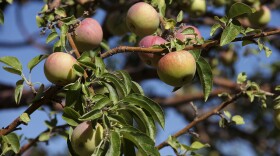This year has been a difficult one for fruit growers on the Western Slope. As fruit picking season develops, the realities of the weather we’ve seen are evident.
Steve Ela runs Ela family farms in Hotchkiss in the North Fork. Standing out in his orchard, he knows this year was unusual.
“It’s a crazy year," says Ela, "as most people in the North Fork know, we had a number of hard freezes but one night in particular really hurt all the North Fork and Cedaredge growers.
“That night pretty well took out our apple crop – we maybe have a 5 percent crop this year. Our pear crop is also about 5 percent. We have a handful of plums. Our peach crop is about a 25 percent crop overall, but within that, some varieties have an 80 percent crop and other varieties have nothing,” he says.
Most of his trees bloomed three weeks early, thanks the early spring. Normally that would mean fruits three weeks early, but the cool, wet period we’ve been in has slowed that process. Everything is off, and he can’t predict when he’ll be ready to pick.
“All our marketing is based around when we can start picking," says Ela. "With perishable crops like peaches or cherries, it’s very difficult to wait to start picking and then really work on your marketing because then you’re really behind the gun. What we really need to be doing is having stuffed picked and shipped right away. That’s the best quality.”
This moisture is also spreading mildew and fungal infections around the fruit. The wet is definitely unusual. Joe Ramey is a meteorologist with the National Weather Service in Grand Junction.
“So far we’ve had 7.54 inches of precipitation here at the Grand Junction airport. That’s 2.84 inches above normal. Last year, as an example, we’d had less than 4 inches of rain, so we’re nearly double what we were last year.”
Ramey is quick to point out, though, that a normal year is actually rare.
“What I like to say about climate here in Western Colorado is we never experience average conditions. We have what we call ‘climatological average’- it’s 30 years averaged together. All those 30 years are wacky: they’re dry, they’re wet, hot, cold. We average those together, and very few of those years look like the climatological average.”
Within that noise of data, the warming climate is changing things, affecting the whirlwind weather the Western Slope is used to.
If you’ve noticed unusual things this year, let us know at iseechange.org.




